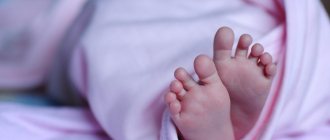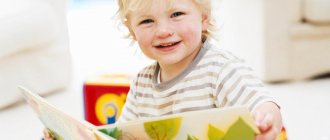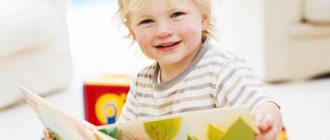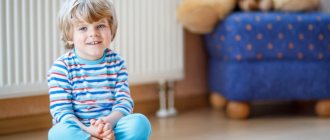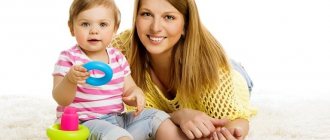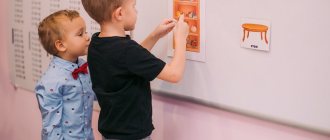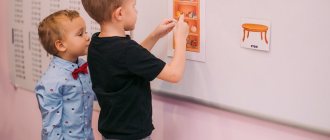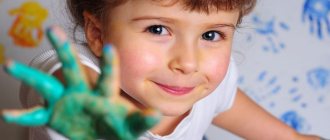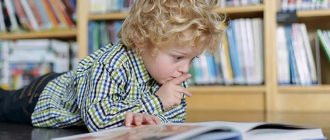November 22, 2016 Doctors and psychologists unanimously say: you need to start raising a child as early as possible, from his birth. Some go even further, suggesting that learning should begin during pregnancy: it is believed that already in the womb the child can perfectly hear everything that is happening around him, so he needs to read books and turn on music. All this contributes to the earlier development of speech in the child, since the ability to speak is an acquired skill.
The child begins to pronounce the first conscious, “human” sounds at about six months, but these skills need to be developed immediately after birth. For full development, including speech development, a little person must feel care and attention from his parents. It is recommended to pick him up more often and talk to the child. This way, you will give him both physical and verbal contact, which will make him feel safe.
At the same time, this will contribute to the development of other senses and skills of the newborn. When a child speaks depends not only on the structure of his speech organ, but also on proper upbringing and training from the first days of life. If in the first weeks after birth the baby's sounds are limited to screaming, already in the second month his speech will change. At this time, individual sounds appear: at such moments, it is very important for the child to get the mother’s approval so that he is sure that he is doing everything correctly.
It is recommended to repeat the same sounds after him and accompany this with a smile. You can then add your own sounds as children learn by imitating adults. Another great way to develop your child's speech abilities is through music. In order for speech to develop in the correct way, it is advisable to play quiet but rhythmic melodies. Children's songs are well suited for this, in which the rhythm and individual sounds and syllables are clearly expressed.
Physical development of a one-year-old child
Statistics show that, on average, one-year-old children weigh 10-11 kg, and their height is approximately 72-77 cm. In this case, weight gain should be about 350 g per month, and height - 1.5 cm per month. After a year, the pace of the child’s physical development will gradually slow down.
Many mothers unwittingly compare their child's development with the development of other children, which causes many reasons for concern. “What if there’s something wrong with him?”, “I probably don’t do enough with the child,” and so on. It is worth noting that the pace of physical development up to one year is individual for each child. In this regard, only a really strong lag from the average statistical norm should be a reason for concern.
As a rule, by the age of 1 year, a child can sit, stand (with support), actively crawl and begin to take his first steps. One-year-old babies love to walk along the support and by the hand, and some even try to run. Also, with the help of an adult, the baby can slowly go up and down the stairs, climb on and off the sofa. Thanks to the ability to maintain an upright position, the baby's ability to explore the world expands. This is a very important step in the development of the baby. To help your child learn to walk confidently, do not force your help on him. Let the baby learn to walk short distances on his own, for example, to you or to a toy. Belay him at arm's length.
Since children of this age love to conquer all kinds of peaks, it is necessary to provide the child with proper safety. Do not leave your child unattended in a room with open windows, shelves that could be knocked over, electrical outlets, wires, or other dangerous objects.
What influences speech development
Somatic health: condition of the hearing aid and central nervous system. May be due to hereditary or external reasons. Among nutritional factors, it is worth paying attention to important nutrients, which are the main building material for brain cells: docosagescaenoic acid (omega-3), taurine, phospholipids, lecithin, sphingomyelins. Motor activity and motor skills. There is a clear connection between a child’s lack of physical activity and a slowdown in the formation of motor speech skills.
Sensory experience or lack thereof. A variety of visual, sound, tactile, olfactory, and taste stimuli expands the range of sensory perception. The more widely developed the neural network and the more neural connections between brain cells, the easier it is to develop various skills.
The baby's environment is a key factor in development. The extent to which the baby is immersed in the promise and involved in communication between family members shapes and determines the child’s interest in speech. On the other hand, balance is important. If the family is multilingual, then there are too many incentives for development. This can lead to confusion and delays in developing understanding and verbal communication.
Psychomotor development at 1 year
The baby’s mental development also does not stand still. Children at 1 year old can:
- Open and close doors, cabinets;
- Pull out drawers;
- Scoop up water;
- Collect pyramids of 2-3 rings;
- Build towers from 2 cubes;
- Putting things in a box;
- Play with sorters;
- Throw the ball;
- Roll the ball on the floor;
- Copy the actions of an adult: combing, cooking porridge, etc.
At 1 year old, children mainly learn about the world through feeling (tactile method). Also, the child can still put things in his mouth, tasting things. Children learn a lot by imitating adults. The baby can copy mom, who is preparing dinner, and try to imitate dad, who is repairing the car. Therefore, it is very important to remember that although the child does not always listen to you, he will always repeat after you and adopt your behavior model.
Speech development
Speech is the highest mental function, integrating many functional systems.
Formation occurs as the corresponding areas of the brain mature.
Pre-speech period
– pre-verbal communication system
- 0 – 3 months – emotional and expressive reactions
- 3 – 6 months – vocal reactions (humming and babbling)
- 6 – 10 months – active babbling, beginning to understand speech
- 10 – 12 months - appearance of the first words
| Age | Speech skills | Understanding |
| 1st month | Screaming, grunting | Responsive to sounds and speech of adults |
| 1-3 months | Sound and auditory concentration “revitalization complex” humming | * |
| 3-6 months | Active humming, the appearance of sounds with vowels (“ba”, “pa”), the transition from humming to babbling | * |
| 6 months | Pronounces individual syllables | * |
| 7 months | Babble. Repeats syllables | To the question “where?” The gaze finds an object in a permanent place: for example, a watch, a doll |
| 8 months | Pronounces syllables loudly, clearly and repeatedly. | Finds 2-3 objects, performs previously learned actions, for example, “okay”, “give me a pen” |
| 9 months | Imitating an adult, repeats syllables that are already in his babble | Finds an object, regardless of its location. Knows his name |
| 10 months | Repeats new syllables after adults | At the request of “give”, finds and gives familiar objects, performs learned actions and movements |
| 11 months | Pronounces the first simplified words “kis-kis”, “av-av” | First generalizations: dolls, cubes, balls |
| 12 months | Says up to 6–10 facilitated words, repeats new words | Understands the names of several objects without being shown, understands the word impossible, carries out individual assignments |
The formation of active speech
- 1 – 2 years – elementary phrasal speech
- 2 – 3 years – simple grammatical structures, word creation
Speech period
- 3 – 7 years – retelling, abstract speech, development of auditory control skills
Period of writing
- 7 – 17 years – sound analysis and mastery of the rules of speech construction
Social-communicative and speech development of a one-year-old child
The repertoire of expressed emotions in one-year-old children is already quite rich. A child can express his need by crying, being scared, or laughing. Body language and facial expressions are improved. The baby often shows feelings for you through hugs and kisses.
A big leap occurs in the development of a child’s speech. By the age of one year, babies usually already know how to pronounce syllables and simple words (mom, dad, baba, bibi, etc.). A child at this age can well grasp the intonation with which he is addressed and fulfills simple requests from an adult. There are no clear age limits for when exactly a child should speak. If you doubt that your baby’s speech development is within normal limits, seek help from a specialist to rule out problems such as hearing impairment, problems with the speech apparatus, neurological diseases, etc.
If your baby still doesn’t speak at one year old, but still understands you, don’t rush to sound the alarm. Talk to your child more and develop his fine motor skills.
Results of the first year
Thus, in the first year it is important to form impressive speech and develop an understanding of the speech of surrounding adults.
At the stage of the pre-speech period, the leading aspects are aspects of socio-communicative behavior and components of non-verbal (wordless) communication.
By the end of the first year, it is important not only how many words the baby speaks, but also how he can understand and communicate.
Main events of the pre-speech period:
- reacts to his name
- understands simple instructions (5-10): “bring something”, “give something”, “show me where”, etc.
- responds with facial expressions and gestures: nodding, denying, shrugging, etc.
- forms babbling chains: ba-ba-ba, pa-pa-pa, etc.
- distinguishes intonations
- understands spoken speech: “you can’t”, “stop”, “go”, etc.
- reacts emotionally to pictures and speech of an adult
- pays attention to the speaker's face
- recognizes familiar objects and faces in illustrations and photographs
Daily and nutritional regimen for 1 year old children
Many mothers of one-year-old children face the problem of changing their routine. Often a baby at this age has difficulty falling asleep during the day, so naps are postponed until later. With the transition to one nap during the day, you need to adjust the child’s diet. Typically, meals are eaten 4 times: for example, at 9 am - breakfast, at 1 pm - lunch, at 17 pm - afternoon snack and at 21 pm - dinner. At the same time, going to bed turns out to be quite late: at 22 - 23 pm.
The diet of a one-year-old child should exclude allergenic foods: chocolate, smoked meats, spices. Some doctors advise continuing to give the baby formula, but not in a bottle, but on a plate. Gradually transition your child to adult foods. To help your baby develop a chewing reflex, replace the puree with small pieces of not very hard food. It can be cutlets, fruits, bread.
Motor activity of the child
What a one-year-old child can do cannot be compared with his skills just a few months ago. He has already learned much better how to handle his own body, he is very active, moves a lot and in a variety of ways. The baby can calmly hold two objects in his hands, can assemble a pyramid, or even hold a spoon at the table while feeding. Of course, in many activities he still needs the help of his parents: such young children are able to concentrate on something for only a few minutes.
Active movements.
The child crawls, stands on his legs, including from a squatting position, and gets up on his knees independently. He can climb on or off a chair or sofa, and with the help of his parents, he can go up or down the stairs. Children are very inquisitive, so at this age they should not be left near open windows or dangerous objects. The kid can figure out how to get to the windowsill using a chair. Fine motor skills become much better: the child can pick up a small object with two fingers, take a cup and drink from it.
Dancing.
Little children love music. Many people notice that, having heard an interesting melody, the baby begins to dance actively: he likes it. Some not only dance, but also try to sing along to children's songs. If the child does not do this, you can show him a simple dance, and he will begin to repeat without prompting from mom or dad.
Moving quickly on all fours
. Almost all babies at this age are already crawling, and quite quickly. Some skip the stage of walking on all fours and immediately stand on their feet, but this does not happen for everyone. Most often, a one-year-old child moves calmly by crawling.
Walking with parental support.
Some children are already starting to take their first steps. Few people begin to walk independently, but most babies can already walk unsteadily while holding mom or dad’s hand. Some people try to walk while holding onto walls or other support. However, there are also children who are in no hurry to start walking on two legs, and this is completely normal. If your child has not gone yet, there is no need to rush him. Dr. Komarovsky suggests that in such cases, holding off on walking may even be useful: walking upright is a serious load on the back, and perhaps the baby is simply not ready for it yet [1].
Health of a one-year-old child
A visit to the pediatrician every year is considered a mandatory procedure. The doctor takes the necessary tests from the child and makes physiological measurements. The issue of child vaccination is also being addressed. It is also necessary to visit the following specialists: neurologist, surgeon, orthopedist. Additionally, it is advisable to consult an ophthalmologist and dentist.
An important component of a healthy lifestyle is maintaining the child’s personal hygiene. At one year of age, a baby can learn to wash his hands before eating and after a walk, as well as wash himself. If a child has grown at least 1 tooth, it is worth making friends with a toothbrush. And, of course, do not ignore evening bathing and rinsing in the shower.
How to promote children's development? Practical advice
All parents want their child to grow up healthy and develop in accordance with his age. It is also natural to want to encourage children to learn new skills. What conditions will contribute to the development of the baby and how to ensure them?
Here's what the World Health Organization recommends:
- A one-year-old child should engage in various physical activities of any intensity for at least 180 minutes a day.
- The mobility of a awake child should not be limited for more than an hour at a time, and he should not sit for an extended period of time in strollers, child seats, baby carriers or baby carriers. During these periods, the child needs to provide communication with an adult, for example, read a fairy tale, listen to fluent speech.
- One-year-old children are not recommended to watch cartoons or spend time with TV or gadgets.
- A 12-month-old child should have a sleep-wake schedule, with at least 11 hours of sleep per day.
How to develop gross and fine motor skills in a child?
Do some modeling and drawing. These exercises also help develop the child's color perception and imagination.
Play with sand. This stimulates creative imagination, perception of shapes and colors. Collective games in the sandbox with other children improve communication skills.
The child’s speech also depends on how developed the motor skills of children’s hands and feet are, since the main method of cognition at this age is sensory. Therefore, let your child play more, using a variety of things - from balls to water.
How to develop speech in a child?
Talk to your children as much as possible. At one year old, they can already be introduced to the names of clothing, household items, toys or animals.
Read every day. This has a good effect not only on speech - books with bright pictures and three-dimensional elements stimulate the development of spatial thinking and imagination.
Play story games. Regular communication in this form will be very useful.
Communication with other children has a good effect on the development of speech skills.
How to strengthen a child's immunity?
Go swimming. Exercises in water help strengthen the musculoskeletal system, develop coordination and immunity. Even bathing in a regular home bath with toys will be beneficial.
Practice hardening. Start with ventilation while changing a diaper and changing clothes, gradually moving on to maintaining a cool temperature in the rooms (optimal values are 20-22 degrees). Then move on to experiments with water - after a hot bath, water the child with water at a lower temperature (but not cold!), wipe the limbs, back and chest with cool salt water.
Read more about the rules for hardening children and adolescents.
One year of age is the most important period in a child’s life, during which the foundation for his further growth and development, both physical and mental, is formed. It is very important that the process proceeds harmoniously, in accordance with general pediatric standards. However, all children are different, some begin to walk later, others speak, so you should not artificially stimulate them, pushing them to what they are still ready for. Everything has its time! The parent's job is to gently guide the baby.
How to develop a child at 1 year old
To help your baby develop quickly and acquire more and more new skills, help him with this:
- Carry the child in your arms less, give him freedom of movement.
- Voice everything you see to your child and talk to him. Read books to your baby - this is so important for the development of a child’s speech.
- Play educational games: sorters, cubes, pyramids, lacing, etc. You can offer your child a simple role-playing game (for example, construction, racing, etc.). Finger games are good.
The development of a 1 year old baby largely depends on his parents. Spend more time with your child, play, talk to him, walk. Provide your baby with new bright impressions, then his development will certainly go uphill!
EDUCATIONAL GAMES
— Ekaterina Borisovna, what needs to be done so that the child develops well?
— Unfortunately or fortunately, there is no single correct model of education. Each child is individual. But there are basic principles on which full-fledged healthy development is built. The task of parents at this stage is to encourage in every possible way any attempts by the baby to explore the world and to make this process as safe as possible.
For example, if a child...
- opens the door - make sure he doesn’t pinch his fingers;
- climbs onto the sofa - provide for a soft fall;
- If he wants to eat on his own, give him a spoon.
Give your child the opportunity to choose independently - which toy to take, which direction to go for a walk, which swing to ride on. It is very important during this period to talk through all your actions and explain what is happening. This enriches vocabulary, helps develop speech skills and makes the world clearer and safer for the baby.
— What toys does a child need per year?
— There are a great many games for this age, and they do not require large expenses. You can simply play without purchasing any toys, or instead of buying expensive copies, you can make similar items yourself. Even playing with cereals or pasta of various sizes and shapes is useful. The main thing is to remember safety when working with small elements and not let your baby’s hands out of your sight for a minute.
How to develop a baby at 1 year old
Games for developing motor skills
| Games for the development of sensory and motor skills
| Speech development games
|
— Do I need to do special physical exercises?
— Gymnastics and massage are carried out daily at the same time, so that the baby is ready for the regime and awaits the procedure. Regular exercise has a beneficial effect on the health and well-being of the child. It is better to exercise an hour before or after a meal, in a playful way. You cannot forcefully insist on a lesson, and if the child is not in a good mood, it is better to postpone the “lesson” to a later date.
Basic physical exercises for children from 1 year:
- walking along a narrow path, an inclined plane;
- walking with side steps;
- running in place;
- jumping, squats;
- playing with a ball or other toys;
- crawling, climbing, overcoming obstacles;
- exercises to develop the upper shoulder girdle.
— Are educational activities for one-year-old children outside the home relevant?
— The child receives new information every minute, and even simple everyday activities develop and teach him. At one year of age, normal activities at home with mom are enough. Gymnastics, drawing, reading books, songs, walks - all this is an inexhaustible source of knowledge and life experience for a child.
Group classes at this age are pointless. The child cannot concentrate his attention on an object for a long time, gets tired quickly, and gets distracted. Additional contacts with strangers are also not beneficial for the still developing immunity.
— Then how to find a balance between development and relaxation?
— It is very important not to overdo it with early development and not to fill the baby’s time with activities, he must learn to entertain himself. The educational program in one year should consist of a maximum of 3 blocks of 10 minutes at different times.
For example,
- morning - gymnastics and outdoor games, pauses between blocks should also be carried out dynamically;
- day - sensory skills and games with pyramids, cubes, finger painting;
- evening - speech development, quiet reading, singing, playing with pictures.
Such classes will be most effective. Between them the child can walk, play, and relax.
Possible causes of the problem
Speech development in a baby may be slowed down for the following reasons:
- Mental disorders. They can range from minimal brain dysfunction to severe dementia.
- Hearing loss (acquired and congenital). The degree of hearing loss varies, and the stronger it is, the worse the situation with speech.
- Social factors. If parents do not care about the speech development of their child, he will speak poorly, even if he is completely healthy.
- Pathologies of the development of the articulatory apparatus. Any disruption of the functioning of the organs responsible for the reproduction of sounds is fraught with speech delay or even complete muteness.
The saddest thing is that, regardless of the cause of a child’s speech delay, it always entails a slowdown in mental development. And the longer parents ignore the problem, the higher the likelihood that the child will become mentally disabled.
